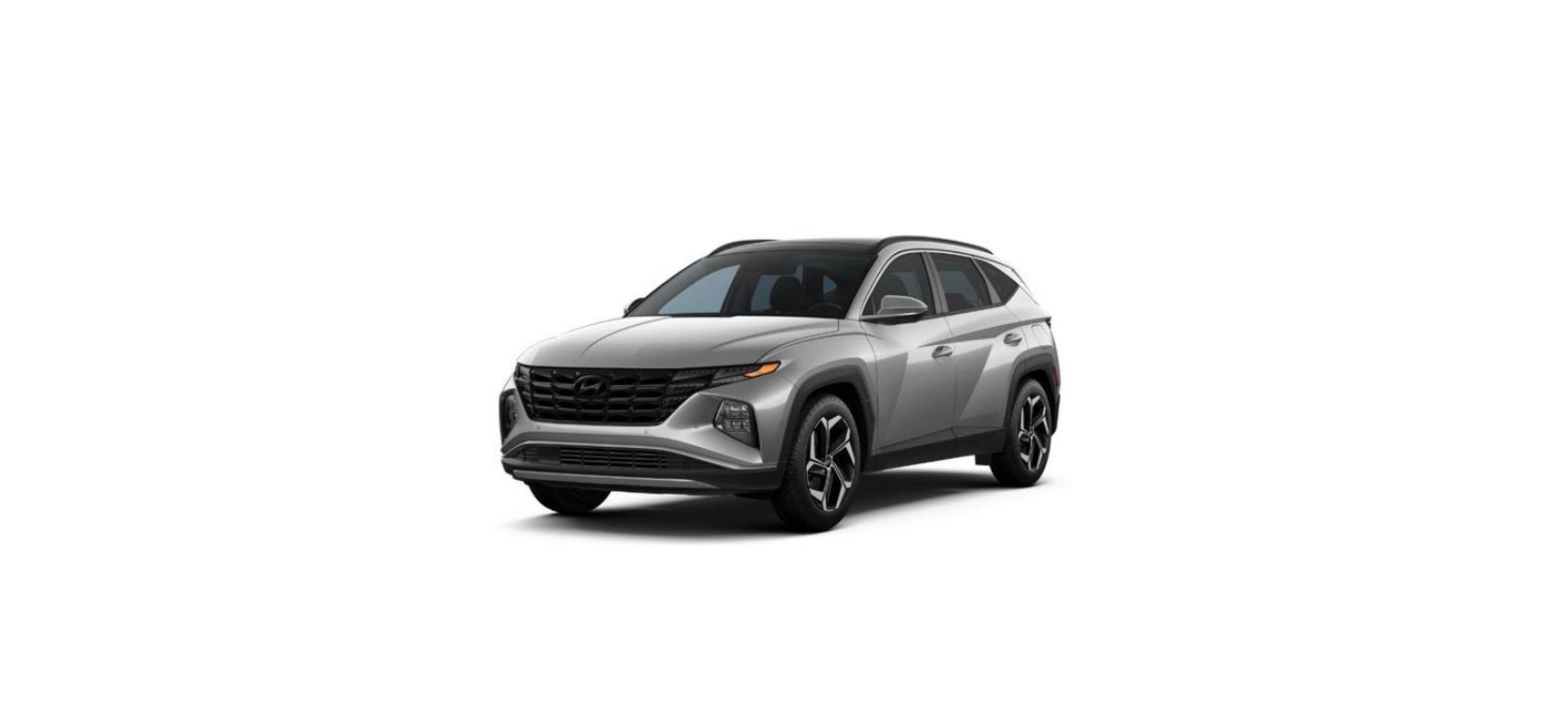2022 Hyundai Tucson Climate Control System User Manual

MANUAL CLIMATE CONTROL SYSTEM (IF EQUIPPED)

- Fan speed control knob
- Temperature control knob
- Front windshield defroster button
- Rear window defroster button
- A/C (air conditioning) button
- Air intake control button
- Mode selection button
Heating and air conditioning
- Start the engine.
- Set the mode to the desired position.
To improve the effectiveness of heating and cooling, select:
- Heating:

- Cooling:
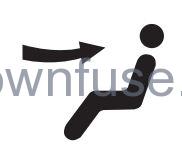
- Set the temperature control to the desired position.
- Set the air intake control to the outside (fresh) air position.
- Set the fan speed control to the desired speed.
- If air conditioning is desired, turn the air conditioning system on.
Mode selection
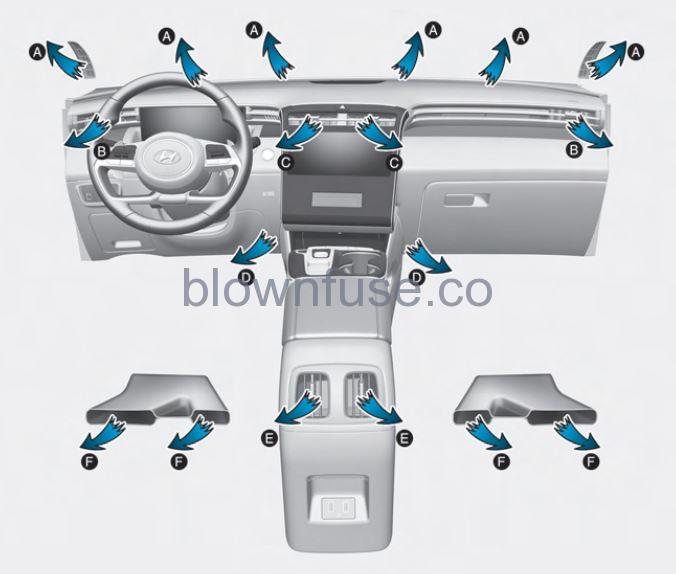
The actual shape of air conditioner may differ from the illustration.
The mode selection button controls the direction of the air flow through the ventilation system.
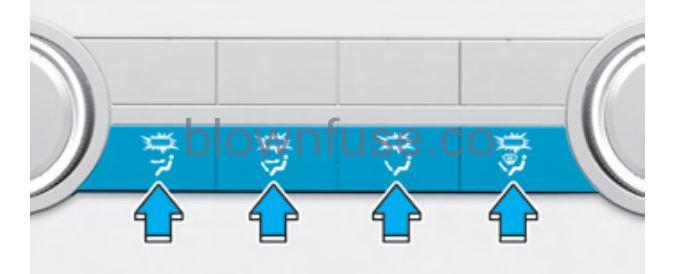
 Face-Level (B, C, E)
Face-Level (B, C, E)
Airflow is directed toward the upper body and face. Additionally, each outlet can be controlled to direct the air discharged from the outlet.
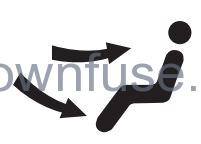 Bi-Level (B, C, D, E, F)
Bi-Level (B, C, D, E, F)
Airflow is directed towards the face and the floor.
 Floor-Level (A, B, D, E, F)
Floor-Level (A, B, D, E, F)
Most of the airflow is directed to the floor, with a small amount of the air being directed to the windshield and side window defrosters.
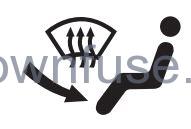 Floor/Defrost-Level (A, B, D, E, F)
Floor/Defrost-Level (A, B, D, E, F)
Most of the airflow is directed to the floor and the windshield with a small amount directed to the side window defrosters.
![]() Front defroster (A, B)
Front defroster (A, B)
Most of the airflow is directed to the windshield with a small amount of air directed to the side window defrosters.
MAX A/C-Level (B, C, E)
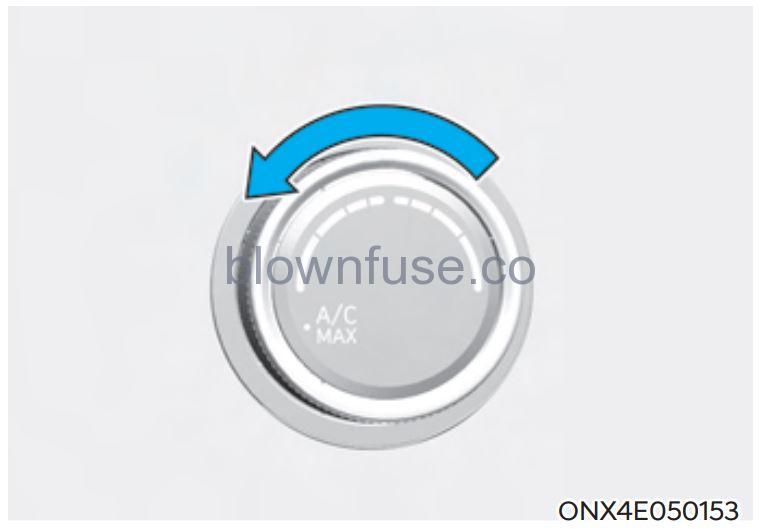
- The MAX A/C mode is used to cool the inside of the vehicle faster. Airflow is directed toward the upper body and face.
- In this mode, the air conditioning and the recirculated air position is selected. Turn the fan speed mode to adjust.
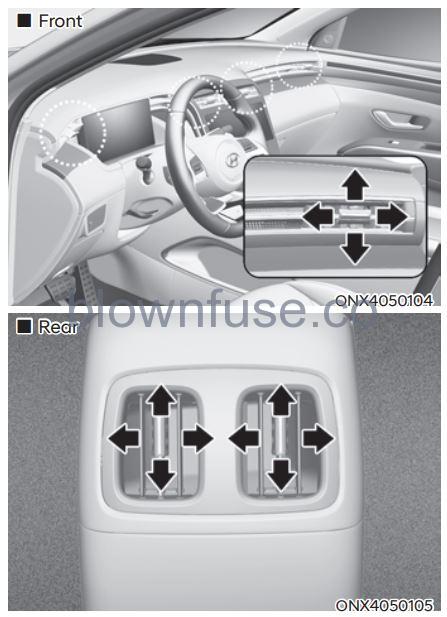
Instrument panel vents
The instrument panel vent air flow can be directed up/down or left/right using the vent adjustment lever. The air flow can also be CLOSED using the vent adjustment lever.
Temperature control
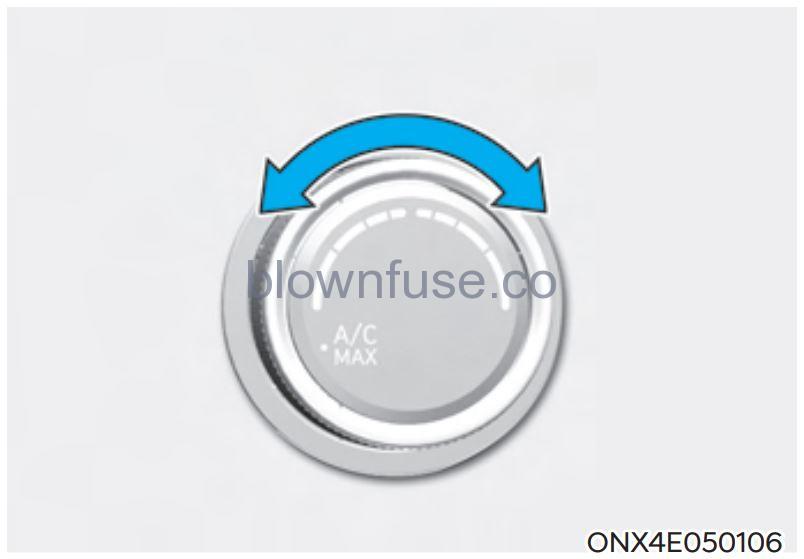
The temperature will increase by turning the knob to the right. The temperature will decrease by turning the knob to the left.
Air intake control
This is used to select outside (fresh) air position or recirculated air position. To change the air intake control position, press the control button.
Recirculated air position
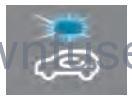 With the recirculated air position selected, air from the passenger compartment will be drawn through the heating system and heated or cooled according to the function selected.
With the recirculated air position selected, air from the passenger compartment will be drawn through the heating system and heated or cooled according to the function selected.
Outside (fresh) air position
 With the outside (fresh) air position selected, air enters the vehicle from outside and is heated or cooled according to the function selected.
With the outside (fresh) air position selected, air enters the vehicle from outside and is heated or cooled according to the function selected.
Information
Using the system in the fresh air position is recommended. Prolonged operation of the heater in the recirculated air position (without air conditioning selected) can cause fogging of the windshield and side windows and the air within the passenger compartment will become stale. In addition, prolonged use of the air conditioning with the recirculated air position selected will result in excessively dry air in the passenger compartment.
WARNING
- Continued climate control system operation in the recirculated air position may allow humidity to increase inside the vehicle which may fog the glass and obscure visibility.
- Do not sleep in a vehicle with the air conditioning or heating system on. It may cause serious harm or death due to a drop in the oxygen level and/or body temperature.
- Continued climate control system operation in the recirculated air position can cause drowsiness or sleepiness, and loss of vehicle control. Set the air intake control to the outside (fresh) air position as much as possible while driving.
Fan speed control
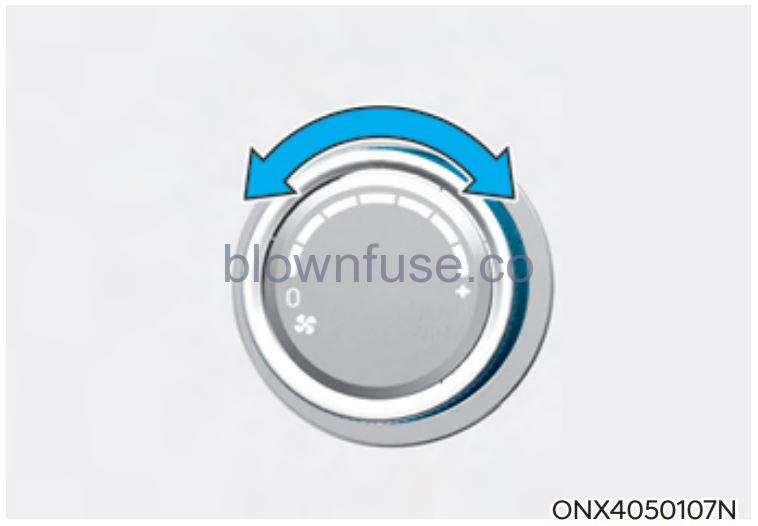
Turn the knob to the right to increase the fan speed and airflow. Turn the knob to the left to decrease fan speed and airflow. Setting the fan speed control knob to the “0” position turns off the fan.
NOTICE
Operating the fan speed when the ignition switch is in the ON position could cause the battery to discharge. Operate the fan speed when the engine is running.
Air conditioning (A/C) (if equipped)
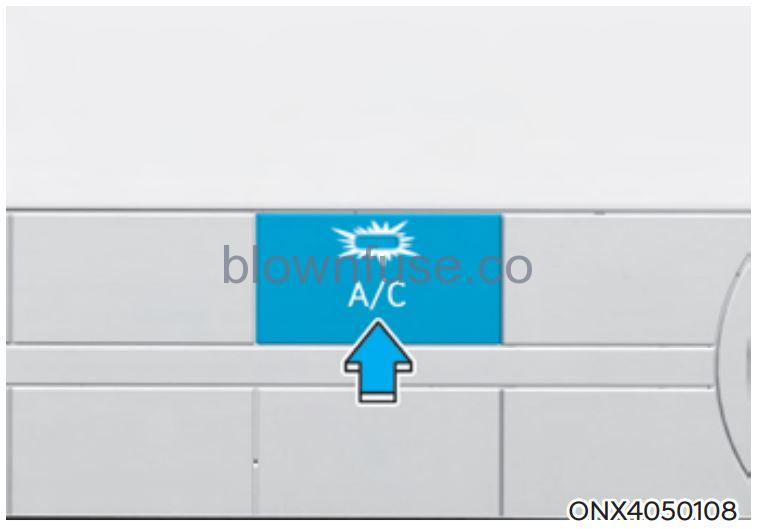
Press the A/C button to turn the air conditioning system on (indicator light will illuminate). Press the button again to turn the air conditioning system off.
System operation
Ventilation
- Set the mode to the
 position.
position. - Set the air intake control to the outside (fresh) air position.
- Set the temperature control to the desired position.
- Set the fan speed control to the desired speed.
Heating
- Set the mode to the
 position.
position. - Set the air intake control to the outside (fresh) air position.
- Set the temperature control to the desired position.
- Set the fan speed control to the desired speed.
- If desired, turn the air conditioning ON with the temperature control knob set to heat in order to dehumidify the air before it enters into the cabin.
If the windshield fogs up, set the mode to the or
or  position.
position.
Operation Tips
- To help keep dust or unpleasant fumes from entering the vehicle through the ventilation system, temporarily set the air intake control to the recirculated air position. Be sure to return the control to the fresh air position when the irritation has passed to keep fresh air in the vehicle. This will help keep the driver alert and comfortable.
- To prevent interior fog on the windshield, set the air intake control to the fresh air position and fan speed to the desired position, turn on the air conditioning system, and adjust the temperature control to the desired temperature.
Air conditioning
HYUNDAI Air Conditioning Systems are filled with R-1234yf refrigerant.
- Start the engine. Push the air conditioning button.
- Set the mode to the
 position.
position. - Set the air intake control to the outside air or recirculated air position.
- Adjust the fan speed control and temperature control to maintain maximum comfort.
Information
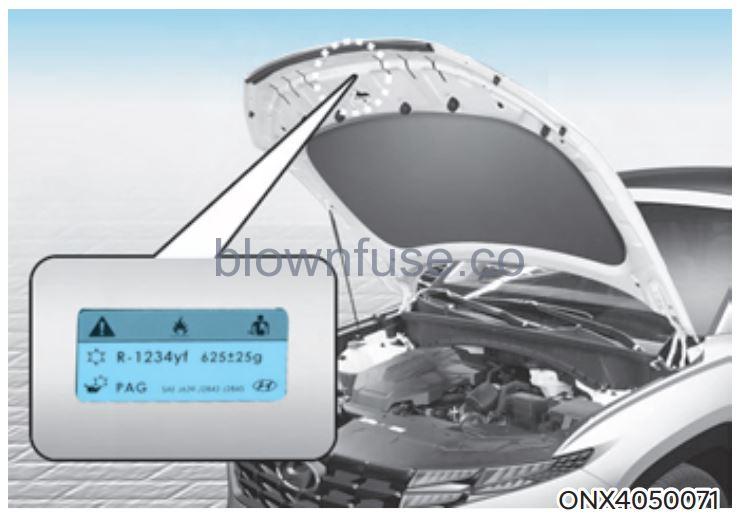
Your HYUNDAI vehicle is filled with R-1234-yf refrigerant. Information regarding the refrigerant designation for your vehicle can be found on the information label located under the hood. Refer to chapter 8 for the location of the air conditioning refrigerant label.
NOTICE
- The refrigerant system should only be serviced by trained and certified technicians to insure proper and safe operation.
- The refrigerant system should be serviced in a well-ventilated place.
- The air conditioning evaporator (cooling coil) shall never be repaired or replaced with one removed from a used or salvaged vehicle and new replacement MAC evaporators shall be certified (and labeled) as meeting SAE Standard J2842.
NOTICE
- When using the air conditioning system, monitor the temperature gauge closely while driving up hills or in heavy traffic when outside temperatures are high. Air conditioning system operation may cause engine overheating. Continue to use the fan but turn the air conditioning system off if the temperature gauge indicates engine overheating.
- When opening the windows in humid weather air conditioning may create water droplets inside the vehicle. Since excessive water droplets may cause damage to electrical equipment, air conditioning should only be used with the windows closed.
Air conditioning system operation tips
- If the vehicle has been parked indirect sunlight during hot weather, open the windows for a short time to let the hot air inside the vehicle escape.
- After sufficient cooling has been achieved, switch back from the recirculated air to the fresh outside air position.
- To help reduce moisture inside of the windows on rainy or humid days, decrease the humidity inside the vehicle by operating the air conditioning system with the windows and sunroof closed.
- Use the air conditioning system every month for a few minutes to ensure maximum system performance.
- If you operate the air conditioner excessively, the difference between the temperature of the outside air and that of the windshield could cause the outer surface of the windshield to fog up, causing loss of visibility. In this case, set the mode selection knob to the position and set the fan speed control knob to the lowest speed setting.
System maintenance
Cabin air filter
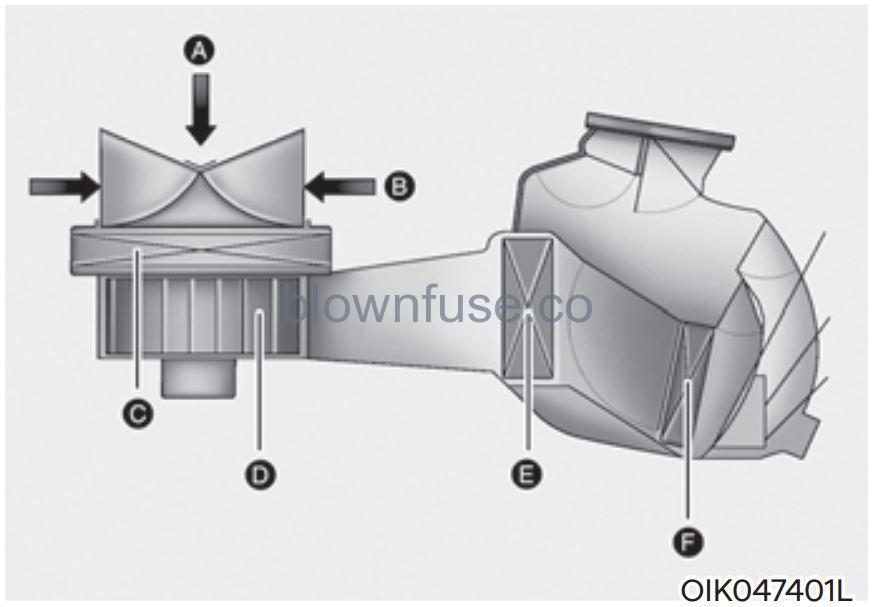
[A] : Outside air,
[B] : Recirculated air
[C] : Cabin air filter,
[D] : Blower
[E] : Evaporator core,
[F] : Heater core
The cabin air filter is installed behind the glove box. It filters the dust or other pollutants that enter the vehicle through the heating and air conditioning system. We recommend that the cabin air filter be replaced by an authorized HYUNDAI dealer according to the maintenance schedule. If the vehicle is being driven in severe conditions such as dusty or rough roads, more frequent climate control filter inspections and changes are required. If the air flow rate suddenly decreases, we recommend the system be checked at an authorized HYUNDAI dealer.
Air Conditioning Performance and Maintenance at Your HYUNDAI Dealer
When the amount of refrigerant is low, the performance of the air conditioning is reduced. Overfilling also reduces the performance of the air conditioning system. Therefore, if abnormal operation is found, we recommend that the system be inspected by an authorized HYUNDAI dealer.
NOTICE
It is important that the correct type and amount of oil and refrigerant is used. Otherwise, damage to the compressor and abnormal system operation may occur. To prevent damage, the air conditioning system in your vehicle should only be serviced by trained and certified technicians.
WARNING
Vehicles equipped with R-1234yf
![]() Since the refrigerant is mildly flammable and operated at high pressure, the air conditioning system should only be serviced by trained and certified technicians. It is important that the correct type and amount of oil and refrigerant are used.
Since the refrigerant is mildly flammable and operated at high pressure, the air conditioning system should only be serviced by trained and certified technicians. It is important that the correct type and amount of oil and refrigerant are used.
All refrigerants should be reclaimed with proper equipment. Venting refrigerants directly to the atmosphere is harmful to individuals and the environment. Failure to heed these warnings can lead to serious injuries.

Air Conditioning refrigerant label You can find out which air conditioning refrigerant is applied to your vehicle on the label located inside of the hood.
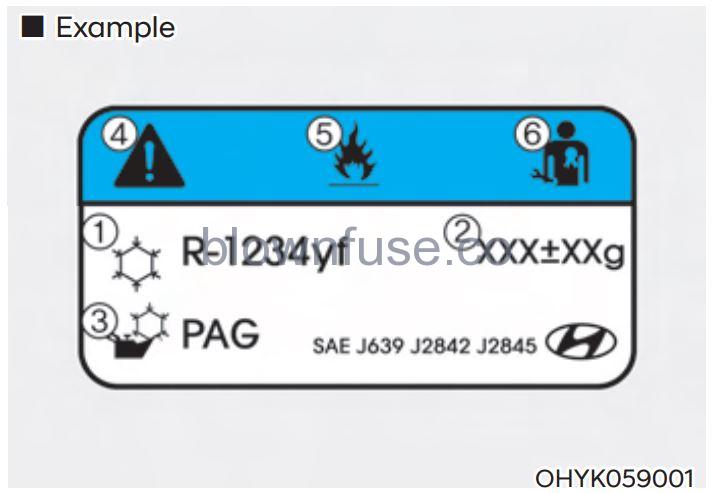
Each symbol and specification on the air conditioning refrigerant label is represented as below:
- Classification of refrigerant
- Amount of refrigerant
- Classification of compressor lubricant
- Caution
- Flammable refrigerant
- To require a registered technician to service air conditioning system.
